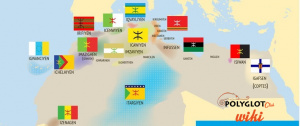Language/Kabyle/Grammar/Nouns-and-gender
| ◀️ Introducing yourself — Previous Lesson | Next Lesson — Pronouns ▶️ |
Introduction[edit | edit source]
In this lesson, we will explore the concept of gender in Kabyle nouns and how to recognize and use masculine and feminine nouns. Understanding gender is essential for building sentences correctly in Kabyle and communicating effectively in the language. We will delve into the details of gender, providing numerous examples to illustrate each point. Additionally, we will explore any regional variations in the usage or understanding of gender in Kabyle nouns, as well as share interesting cultural facts and anecdotes related to this topic.
By the end of this lesson, you will have a solid understanding of noun gender in Kabyle and be able to confidently use masculine and feminine nouns in your conversations.
Gender in Kabyle Nouns[edit | edit source]
In Kabyle, like in many other languages, nouns are classified into two genders: masculine and feminine. The gender of a noun determines the form of other elements in a sentence, such as articles, adjectives, and pronouns, that agree with the noun. It is important to note that gender in Kabyle is not always predictable based on the form or meaning of the noun, so it must be learned and memorized.
Let's begin by looking at some examples of masculine and feminine nouns in Kabyle:
| Kabyle | Pronunciation | English |
|---|---|---|
| ⵎⵓⵏⵉ | munni | house (masculine) |
| ⵢⴰⵏⵣⵓ | yanẓu | water (masculine) |
| ⴰⵎⵔⴰⵔ | amrar | moon (masculine) |
| ⵉⵣⴰⵡⵉⵏ | izawin | women (feminine) |
| ⵡⵉⵙⵖⵉⵏ | wisgin | cat (feminine) |
| ⵡⵉⴷⵍⵉⵍ | widlil | heart (feminine) |
As you can see from the examples above, masculine nouns often end in a consonant, while feminine nouns often end in the vowel "i" or "u". However, this is not a strict rule, and there are exceptions. It is important to pay attention to the gender of nouns when learning new vocabulary.
To determine the gender of a noun, you can also look at the article that precedes it. In Kabyle, the definite article "the" has different forms depending on the gender of the noun. The masculine definite article is "as" and the feminine definite article is "t" or "tt". Let's see some examples:
| Kabyle | Pronunciation | English |
|---|---|---|
| ⴰⵙⵉⵔ | asir | the man (masculine) |
| ⵜⵉⵣⵣⴰⵡⵉⵜ | tizzawit | the woman (feminine) |
| ⵉⵣⴰⵡⵉⵏ | izawin | the women (feminine) |
| ⵜⵉⵣⵣⴰⵡⵏ | tizzawn | the cats (feminine) |
Note that the feminine definite article "t" changes to "tt" when it precedes a noun that begins with a vowel. This is called the "sandhi" rule in Kabyle.
Regional Variations and Cultural Facts[edit | edit source]
It is important to note that there may be regional variations in the usage or understanding of gender in Kabyle nouns. Some dialects or regions may have different rules or patterns for determining noun gender. It is always interesting to explore these regional variations and learn from the diverse perspectives within the Kabyle-speaking community.
In Kabyle culture, gender plays an important role in everyday life. For example, certain objects or concepts may be associated with a specific gender. This cultural understanding of gender can also influence the way nouns are used and perceived in the language. For instance, words related to strength or power may be associated with the masculine gender, while words related to beauty or nature may be associated with the feminine gender.
Exercises[edit | edit source]
Now, let's practice what we have learned about noun gender in Kabyle. Complete the following exercises by identifying the gender of the nouns and using the appropriate definite article:
Exercise 1: Identify the gender of the following nouns and choose the correct definite article:
1. ⵏⴰⵡⴰ (nawa) - 2. ⵍⵎⵓⵏ (lmun) - 3. ⴰⵔⴰⵔ (arar) - 4. ⵛⵛⵓⵍ (ccul) - 5. ⵡⵓⵙⵙ (wuss) -
Exercise 2: Complete the sentences with the correct form of the definite article:
1. ⵉⵣⴰⵡⵉⵏ (izawin) - 2. ⴰⵎⵔⴰⵔ (amrar) - 3. ⵡⵉⵙⵖⵉⵏ (wisgin) - 4. ⵢⴰⵏⵣⵓ (yanẓu) - 5. ⵎⵓⵏⵉ (munni) -
Solutions[edit | edit source]
Exercise 1: 1. Feminine 2. Masculine 3. Masculine 4. Masculine 5. Masculine
Exercise 2: 1. ⵜⵉⵣⵣⴰⵡⵉⵜ (tizzawit) 2. ⴰⵙⵉⵔ (asir) 3. ⵜⵉⵣⵣⴰⵡⵉⵜ (tizzawit) 4. ⴰⵙⵉⵔ (asir) 5. ⴰⵙⵉⵔ (asir)
Conclusion[edit | edit source]
In this lesson, we explored the concept of gender in Kabyle nouns and learned how to recognize and use masculine and feminine nouns. We discovered that gender is an important aspect of the Kabyle language and influences the form of other elements in a sentence. We also discussed regional variations in the usage and understanding of gender, as well as cultural facts related to this topic. By practicing the exercises, you have gained a solid understanding of noun gender in Kabyle and are ready to confidently use masculine and feminine nouns in your conversations.
Keep up the great work and continue building your Kabyle language skills!
Sources[edit | edit source]
Other Lessons[edit | edit source]
- How to Use Be
- Pronouns
- Plural
- Plurals
- Conjunctions
- Future tense
- Negation
- Adjectives
- Noun Gender
- Types of nouns
| ◀️ Introducing yourself — Previous Lesson | Next Lesson — Pronouns ▶️ |

